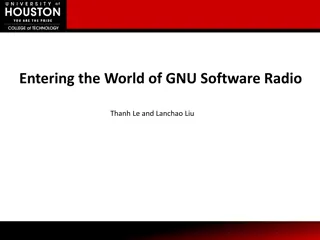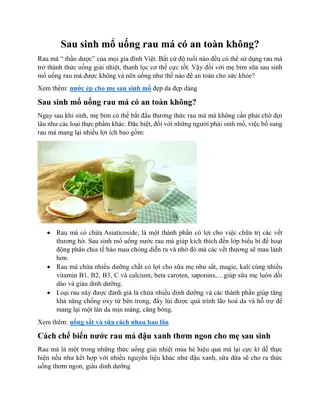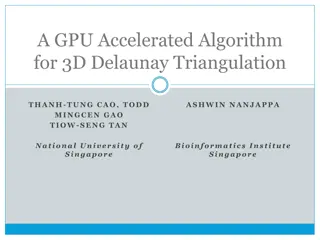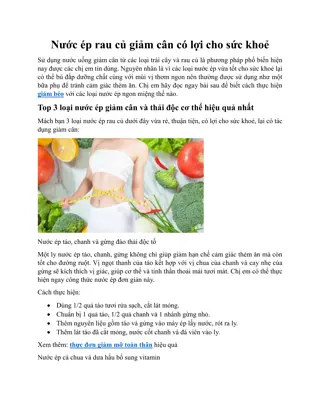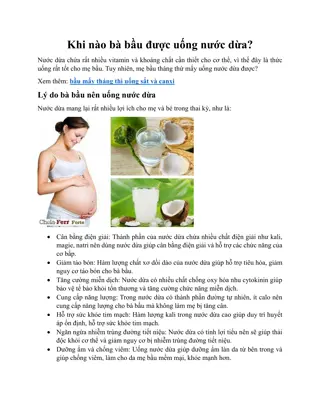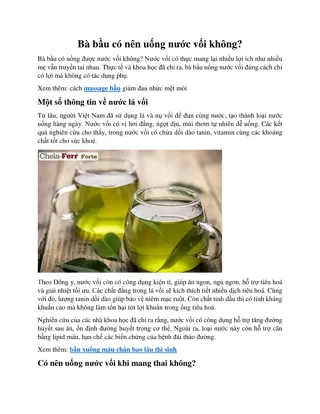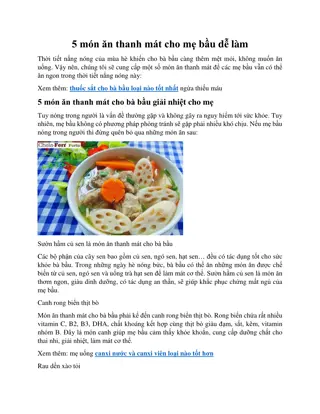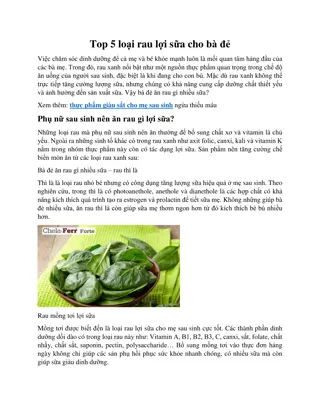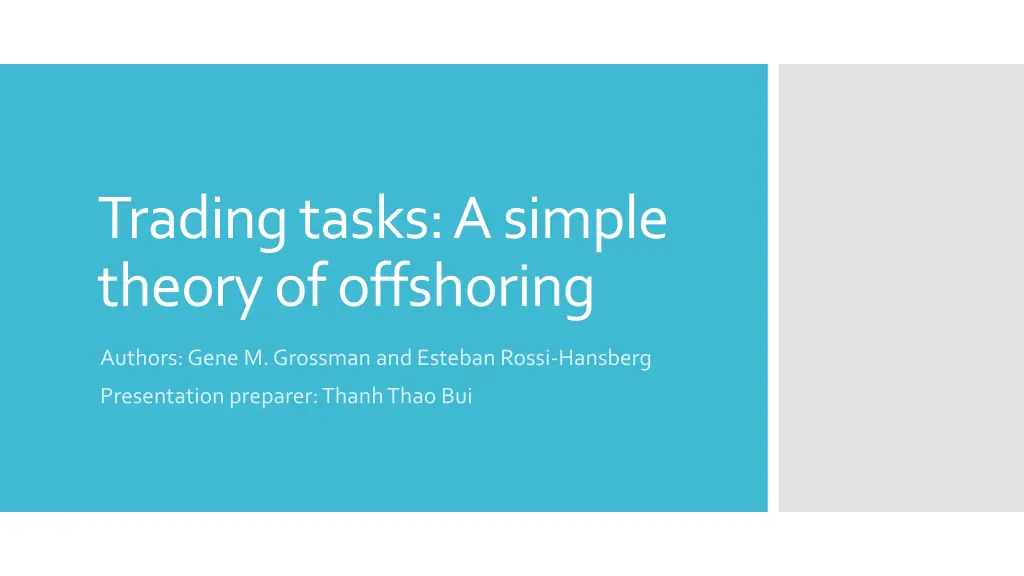
Theory of Offshoring and Wage Effects
Explore the theory of offshoring in "Trading Tasks: A Simple Theory of Offshoring" by Gene M. Grossman and Esteban Rossi-Hansberg. The paper analyzes the impact of falling offshoring costs on source countries, decomposition of wage effects, and offshoring of tasks. Understand the productivity effect, relative-price effect, and labor-supply effect in different economic setups. Discover the implications of offshoring skill-intensive tasks and the noteworthy restrictions in the model.
Download Presentation

Please find below an Image/Link to download the presentation.
The content on the website is provided AS IS for your information and personal use only. It may not be sold, licensed, or shared on other websites without obtaining consent from the author. If you encounter any issues during the download, it is possible that the publisher has removed the file from their server.
You are allowed to download the files provided on this website for personal or commercial use, subject to the condition that they are used lawfully. All files are the property of their respective owners.
The content on the website is provided AS IS for your information and personal use only. It may not be sold, licensed, or shared on other websites without obtaining consent from the author.
E N D
Presentation Transcript
Trading tasks: A simple theory of offshoring Authors: Gene M. Grossman and Esteban Rossi-Hansberg Presentation preparer: Thanh Thao Bui
The current trend and reasons for offshoring General and specific assumptions about the economy to analyse in each part Two outstanding values of the paper Introduction Set-ups of the model Describe an equilibrium with trade in goods and tasks Zero profit function The factor market clearing conditions: for L labor and H labor The model Decomposing the wage effects of offshoring The productivity effect The relative-price effect The labor-supply effect Offshoring H tasks in small Heckscher-Ohlin economy Offshoring H tasks in a large economy and an economy specialized in producing a single good Some other special results Offshoring skill- intensive tasks Summarise main results from the model Two main noticeable restriction Conclusion
Introduction The global trend in recent decades The revolution in the technological area The paper focus on the effect of falling offshoring cost to source countries The current trend and reasons for offshoring 2. Assumption Firms products are created from a continuum of tasks, produced by a specific factor of production These tasks can be proceeded in close or offshoring location A range of locations is chosen >> minimize costs Assumption Section I: No more than two active industries, At least two factors of production, Constant return to scale Perfectly competitive markets Only L-tasks (tasks performed by low-skilled workers) can do offshore (except for part III) represents the ability of offshoring
Section II: Three effects on L wage decomposed: Productivity effect: results from cost saving when doing offshoring and benefits for L labors Relative-price effect: appears when TOT is changed Labor-supply effect: respond between factor supply and prices in the specific relative price Assumption Section IIA: A small economy with 2 goods, 2 factors Fixed term of trade Wages do not response to factor supplies The productivity effect: the only remaining force Section IIB and C: Two types of economy: a large two-sector economy and a high-wage country specializes a single good Section III: H tasks are performed offshore Different productivity effect favoring H labor Two A clear and persuaded offshoring model for multi-applications the productivity is uncovered: grow with the offshoring level outstanding values
The model The production process includes tasks: require single factor of production for each task Two main tasks L-tasks and H-tasks An economy: every firm produces two goods, X and Y, constant returns to scale Production of a unit of either good: a continuum of L-tasks, a continuum of H-tasks Normalization: All tasks in each industry makes use of a given production factor equally to one All L (or H) tasks require similar amount for each task at home country Factor intensities of industries can be different between countries Impossible to substitute between the different tasks and factors >> fix afj afj units of domestic factor f: perform a typical f-task once in the industry f total amount of domestic factor f: produce a unit of good j without any offshoring Industry X: relatively skill intensive >> aHx/aLx > aHy/aLy No different between offshoring tasks taken by firms or by outsourcing other firms i [0,1]: index of L-tasks in an industry, ordered s.t costs of offshoring are nondecreasing: 0 tj (i) aLj tj(i): rquired units of foreign labor : to perform task i of good j Offshoring costs are similar in the two industries: tx(i) = ty(i) = t(i) Substitution between L-tasks and H-tasks possible: aLj and aHj become choice variables for the firms Setups of the model w and w : Home and foreign wage of L labor: w > t(0)w I: the marginal task performed at home: w = t(I)w For markets for consumer goods: identical and homothetic preferences, numeraire good X The relative price p: exogenous or endogenous depending on the size of home country An equilibrium with trade in goods and task
?t i di + s???. + ? + s???. + (2) pj w???(.)(1 ?) + w???(.) 0 (3) pj w???. Where: for j = x, y. for j = x, y. ?? ? ?? 0 ? 1 ? + ?(?) Understanding: The price of any good is less than or equal to the unit production cost RHS: Including: wages paid to domestic L labor, foreign labor to perform offshoring tasks, domestic skilled labor aLj: chosen intensity of task performance w (I): average cost of the L labor used to perform L-tasks ? ?? = Zero profit function ?? ? ?? 0 ? (?) 2 ? ? ? (I) = 1 when I = 0 and >> Offshoring will help reduce production cost of unit product ?? < 0 when I > 0, then (I) < 1 when I > 0 1 ? ???. ? + 1 ? ???. ? = ? ???. ? + ???. ? = ???. ? + ???. ? = ? Factor market clearing condition ? (4) (5) Understanding: Offshoring can be understood as the increase of domestic L factor supply. only L-tasks are moved offshore 1 ?
Decomposing the wage effects of offshoring ?? ? = + 1 ? 2 1 ? Understanding: The first term: productivity effect: d < 0: leads to labor >> increase in their wages The second term: relative-price effect: falls >> equilibrium TOT changes P falls (p= py/px = py) >> the pressure of decreasing the wage of L labor The last term: labor-supply effect: falls >> frees up domestic L labor >> may lead to decline in w < 0: lead to cost saving >> increase in the productivity of L ?? ? = 3 ? + 4 1 ? Understanding: falls >> affect cost of performing L-tasks not H-tasks directly Opposite sign of relative price and labor-supply effect: push the two factor prices in opposite directions
Productivity effect: works for the benefit of the factor moved offshore when I > 0 Setting: A small Heckscher-Ohlin economy, taking relative price p, foreign wage w as given produces output with only two factors, L and H Zero profit condition: 1 = ???? ? + ???? And ? ? + ???? Understanding: Two industries have different factor intensities (afj) >> w and s are independent of >> offshoring production cost falls, ? = ; ? = 0 >> only productivity effect influences w. The level of productivity effect ? ? ? (8) ? ? The ? = ???? (9) productivity effect ?? ? ?? 0 (1 ?)?(?) . ? = = Understanding: The productivity effect is zero when I = 0, but strictly positive when I > 0 Reasons: Cost decreases from tasks that previously were performed at home and from inframarginal tasks conducted abroad even before the drop of >> wage of L labor increases to offset the induced increase in the profitability, wage of H labor lefts unchanged
Different levels of distribution of offshoring costs by task: Ix and Iy for two industries ?? ?? ? ?? ? ?? ? = ?? ?? ?) ( ?? ?? ??. ?? ?? ??[(- ?)] ? = The productivity effect Case 1: Only L-tasks in labor intensive industries (sector Y) can be proceeded offshore Technology for offshoring L-tasks increase ( decreases) The wage of L labor will rise more than the percentage fall in y The wage of H labor will fall Case 2: Offshoring L-tasks is only available in H industry Increase of wage of H labor and the decrease in the wage of L labor
>> lower factor prices in the foreign country in comparison with that in the home country Only firms in the technologically advanced country engage in offshoring The offshoring of L-tasks has the same distribution of costs in the two industries (same I) Zero-profit conditions for indigenous foreign firms 1 = ? ? ??? ? (11) ? = ? ? ??? ? Adjusted factor price equalization: ? ? = ? and ? = ? ? Foreign factor-factor market clearing conditions ? ???? + ? ???? + ? 0 ? ???? + ? ???? = ? , ? and ? : Industry outputs of the indigenous foreign firms in industries X and Y ? and ? : Foreign endowments of L and H labor L labor in foreign country comprises: The demand of indigenous foreign firms in industry X, in industry Y, demand of home firms in both industries Demand for H labor: comes from the demand in both industries in foreign country itself Indigenous firms in the foreign country use inferior technologies ? ? ? ? ? + ? ? ??? (10) ? + ? ? ??? The relative- price effect 1? ? ??(???? + ????) = ?
World outputs of the two goods: ???? +? ? ? +? ? ??? ? ? +? ? + ? = (12) ? ???? +? ? ??? ? ? + ? = (13) ?= ?????? ??????> 0 Where Equilibrium in the goods market requires The relative- price effect ? + ? ? + ? = ? ? , D(p) is the (homothetic) world relative demand for good Y with the property that ? ? < 0 Understanding: A fall in offshoring cost leads to the decrease in the relative price of labor-intensive good ? ? = ?? ? ? = ? 1 ? ? ? + ? ? ?? . 0 Understanding: falls >>reduces the cost of L-tasks ( falls) >> the fall of the relative price of labor- intensive good >> rewards H labor but harms L labor (Stolper-Samuelson reasons)
Setting: a small economy, takes the foreign wage and relative price as given, specialized in producing a single good, the home country produces only the numeraire good X. The factor-market clearing conditions: ? ? ? = ? ? ? = ?. Decomposing the wage effects of offshoring: ? = 1 ?? ?? ??: the elasticity of substitution between the set of L-tasks and H-tasks in the production of good X Understanding: decreases >> Productivity effect which is positive, labor-supply effect on L wages which is negative See specifically the change of ? ? = (?? 1 ?? ? ??? 1 ?, (14) ??? (15) The labor- supply effect ?? 1 ?. (16) ?? ) ?? 1 ?
?(?)(1 ?) ?(?) 0 ?? ? ?? + 1 ? ?(?) ? ? ?? ? ?? ? ? = 0 Understanding: The labor-supply effect is large when 1 ?? is large and ?? is small I = 0, there is only labor-supply effect: no offshoring L-tasks >> no cost saving when performing L-tasks W rises when ???? > 1 ?? For H labor: ? = ?? ?? Understanding: ? is always positive for all I and as dI > 0 Labor-supply effect that may harm L labor but benefits H labor No direct productivity effect H marginal product is boosted: increase in the intensity with which every L-task is performed when there is an expansion in L task trade. The labor- supply effect ?? 1 ?
(17) (18) ????(?): ratio of the input of foreign factor f needed to perform the f-task with index I at a given intensity to the domestic input of factor f needed to perform the same task at the same intensity, for f = {L, H}. The zero-profit conditions 1 = ????? ?? (20) ? = ????? ?? ????? ?? ???? Understanding: The two equations (19) and (20) determine ?? and ?? independently of L and H falls: ? = ? and ? = ? ???= 0. ???< 0: leads to the increase in productivity gain of L labor, no effect to the productivity gain of H labor For a large economy or one that is specialized in producing a single good: fall in ?? implies a relative- price effect that benefits L labor and harms H labor When ??. = ??. = ? . and ??= ??= ?: we have ?? ?? ?? = ? = ?? ?? ?? or ??= ?? Hence, the extent of equilibrium offshoring is the same for the two types of tasks Setting: The small Heckscher-Ohlin economy, offshoring tasks performed by H labor Same schedules of offshoring costs If: the marginal task using factor f performed offshore w = LtL(IL) ? = ? ????(??) ?? ?? ?? ?? ?? + ????? (19) ?? + ????? Offshoring skill- intensive tasks 0 ??? 1 ??+ Where for f = {L, H}. ? ? ???> 0,? ? ???= 0, ? ? ???> 0, and ? ?
Conclusion The model captures the new trend of global supply chain and its consequences for prices, resource allocation and welfare The productivity effect which results from improvements in the technology for trading tasks is identified, like factor-augmenting technological progress This directly boosts the productivity of the factor whose tasks become easier to move offshore Both factors of production can benefit from the decline if the adjustment in relative prices is not too large or its impact on factor prices is not too powerful (Pareto efficient) Summarise main results from the model The substitution between some subsets of tasks carried out by a particular factor of production is not incorporated Transporting processed goods is assume to be costless If shipping cost is considerable, a firm may need to consider grouping tasks together to economize this expense Two main noticeable restriction

